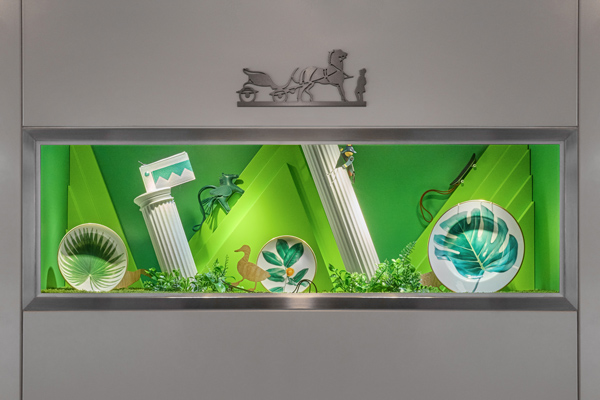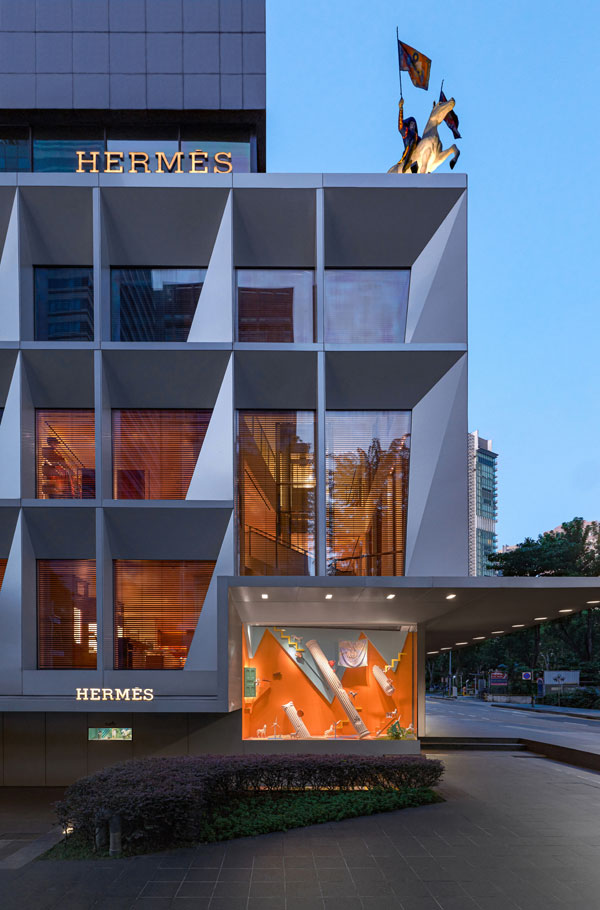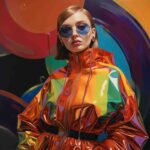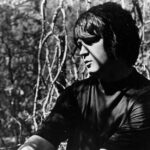Jimin Chae Interprets the Hermès Window with “Three Columns”

(JIMIN CHAE)
On 23 Might 2025, Hermès unveiled its newest artist home windows on the Liat Towers boutique. “Three Columns” is conceived by Seoul-based artist Jimin Chae, whose works blur the traces between fantasy and actuality by way of two-dimensional panorama work that includes disparate and infrequently curious parts. You’d see a site visitors cone seemingly floating mid-air in a single, and animals positioned as if they’ve chanced upon an odd scene in others.
Whereas Chae’s works look extremely crisp and nearly print-like, they’re really painted by hand — as we found by way of an artwork workshop led by the artist himself. The very fact alone makes him the proper collaborator according to Hermès’ working theme for the 12 months, Drawn to Craft.
We chat with Chae to seek out out extra about his inventive course of, how he approached his second collaboration with Hermès, and if the inclusion of horses and the usage of a definite Hermès orange was him manifesting the chance to work with the Maison someday.
Firstly, thanks for the very insightful workshop. You appear very comfy educating, and as I perceive, you additionally do train at an artwork college. Was educating artwork one thing that you simply thought you’d do? How did that come about?
JIMIN CHAE (JC): I’ve been educating college students at artwork academies since my early twenties. For artwork majors, it was one of the accessible part-time jobs that allowed us to utilize our abilities, and I naturally started this work upon the advice of my mentor. Over time, I finally got here to show at Yewon Faculty, a center college specialised within the arts. Now, I strategy this function with a powerful sense of accountability, aiming to instil the best mindset and angle in college students who’re simply starting to pursue the humanities as their chosen discipline.

“Three Columns” by Jimin Chae intentionally blurs the traces between fantasy and actuality.
(HERMÈS)
How did you come to develop your artwork fashion?
JC: In my late twenties, after graduating from college and starting my journey as an artist, I keep in mind striving to specific the visible pressure and coexistence of “flatness” and “spatiality” inside a single canvas. Within the means of setting up an imaginary house born from the artist’s creativeness on the materially flat, white floor of the canvas, I neither selected one attribute over the opposite nor sought to create visible confusion. As a substitute, I aimed to let the 2 qualities coexist in an ambiguous relationship inside the identical body. This pursuit of the imprecise boundary between two coexisting parts has develop into central to my inventive strategy.
In my newer work, I’ve prolonged this exploration past flatness and house to incorporate the ambiguous boundaries between actuality and unreality, nature and artificiality.
Your work entails making a scene out of disparate parts, nearly like a collage, and also you paint them at instances referencing pictures that you simply took your self. What goes behind conceptualising every work? Is there a selected thought earlier than you even start placing the weather collectively?
JC: My work typically begins by setting up incomplete or imperfect buildings inside an indeterminate house that resembles a pure discipline. On this course of, I take advantage of easy 3D software program to regulate mild, shadow, and vanishing factors, composing a extremely calculated and artificially drafted scene. Inside this scene, I incorporate objects, figures, and animals—largely drawn from pictures I’ve taken myself—arranging them in a method that seems harmonious but subtly unnatural, including a way of ambiguous relationships to the composition.
Solely after going by way of these work-planning processes, I transfer on to portray. As you may sense from this description, for me, composition shouldn’t be an emotional course of — it’s a extremely rational one which focuses on the formal qualities of the topic. Extra particularly, I assemble the picture based mostly on visible parts corresponding to form, shade, directionality, and motion.
The colors that you simply use are sometimes vivid and wealthy — they’re very not often moody and even sombre. Why is that?
JC: As talked about, the method of composition in my work entails little or no emotional enter. To be sincere, selecting colors continues to be tougher for me than working with type. Nevertheless, when the colors seem vivid and wealthy, it is actually because I’m utilizing them deliberately—to emphasize the presence of sure buildings or objects positioned inside the scene. Even now, I not often really feel full confidence with regards to color; in actual fact, it stays an experimental side of my follow.
You first labored with Hermès for the Maison’s home windows in Shanghai in 2023. However even earlier than that, you’ve utilised the Hermès orange (and horses too) in fairly plenty of your earlier works. Is there a cause why you gravitate in direction of that shade of orange?
JC: Within the early levels of my follow, the sky served as a key motif by way of which I explored the stress and coexistence between flatness and spatiality. Because of this, a lot of my early works—and even some latest ones—function the sky or flat pictures symbolizing the sky, making blue tones, particularly sky blue, dominant in my palette. Over time, as I started to replicate extra on the usage of various colours, I seemed for a tone that will distinction with the blue hues I steadily used. That led me to orange. To today, sky blue and orange stay the colors I really feel most assured utilizing in my work.
Earlier than discussing horses, it’s extra necessary to clarify why I began portray animals within the first place. In my earlier work, the usage of human figures was fairly chilly and rational. Inside the constructed scenes, the figures would face in numerous instructions, by no means assembly the viewer’s gaze—as a substitute, they turned away or had their faces obscured. This was a deliberate machine to forestall anyone determine from being perceived because the “foremost character.” The characters had been eliminated, leaving solely their gestures behind.
Nevertheless, I started to really feel that this strategy was making the already cool and distant ambiance of the portray really feel much more indifferent from the viewer. That’s after I first started portray wild animals corresponding to mallards, horses, and reindeer. In my works, animals face the viewer and appear to acknowledge their presence. In comparison with human figures, animals are inherently extra emotional topics. This, in fact, is one other instance of the work angle of pursuing the “ambiguous boundary” I discussed earlier.


(HERMÈS)
“Three Columns” is your newest work for Hermès. What have you ever learnt from the primary collaboration that you simply’ve maybe put into follow for this explicit set up?
JC: To place it merely, I approached the given house on the Liat Tower with the mindset: “Let the flatness stay even flatter, and the three-dimensional much more spatial.” This try and create a extra energetic and excessive visible distinction stemmed from what I discovered throughout my first collaboration in Shanghai. Finally, all of it comes right down to the identical query I’ve at all times grappled with in my portray follow: how can the themes I consistently discover on a flat floor be translated and visualized inside an actual, bodily house?
You’ve talked about that loads of the weather in “Three Columns” signify how Hermès continues to problem custom with modernity. What was the conceptualisation course of like for “Three Columns”?
JC: I do not forget that after I was first approached for the collaboration, I used to be given a presentation on how the model reinterprets and makes use of its traditions in a up to date context. What left a very sturdy impression on me was the story of how Robert Dumas discovered inspiration in an anchor chain he got here throughout by the seaside—an commentary that ultimately led to the design of Chaîne d’ancre. What struck me much more was how this single motif has undergone numerous reinterpretations and variations over the previous 80 years, persevering with to be reinvented in various supplies and types. This capacity to acknowledge design worth in one thing seemingly trivial, to create from it, and to maintain that legacy alive by way of fixed trendy reinterpretation—that, to me, defines the id of this model.
I don’t often strategy the canvas with a grand narrative or predetermined that means. My preliminary thought was easy: to sketch out the cube-like house of the Liat Tower’s home windows in my sketchbook, and loosely draw inside it whereas staying true to the theme Drawn to Craft. I drew three diagonal traces falling throughout the house, which turned the “Three Columns”. These slanted traces ultimately took the type of classical Greek columns — not as an intentional image or mythological reference, however reasonably as a technique to introduce a proper pressure into the house.

Nevertheless, because the work progressed, these columns started to tackle new meanings. They began to counsel a movement of time—a construction that hints at custom, the current, and the long run as chance. The objects organized across the columns each reference the model’s heritage and contribute to a subtly fantastical ambiance, blurring the boundary between actuality and creativeness.
Fashionable imaginings constructed upon the stable construction of custom—that, to me, displays the artistic spirit that Hermès persistently pursues. “Three Columns” is my private interpretation and expression of that philosophy.
There’s loads of play between actuality and fantasy in “Three Columns” and I believe it echoes rather a lot about how trend and luxurious are seen as effectively. What is maybe an thrilling half about working with a luxurious maison like Hermès?
JC: That’s an fascinating level. If a luxurious model like Hermès seeks to collaborate with a up to date artist like myself, it’s doubtless as a result of they count on me to strategy the empty house of the window in the identical method I strategy a clean canvas—by way of the lens of my very own course of and perspective.
Whereas trend manufacturers and up to date artists is probably not far aside inside the broad realm of “artwork,” their basic functions are fairly totally different. Vogue, at its core, is constructed upon performance and wonder for the wearer. Artwork, alternatively, typically leans towards leaving room for ambiguity—for feelings and ideas that resist rapid interpretation. That’s why I discover the stress and refined dissonance that come up when these two worlds—with such totally different directionalities—come collectively so fascinating.
You appear very open to others’ artistic concepts and artistry. However how do you deal with criticisms of your personal work?
JC: Precisely. Even inside the worlds I create on canvas, I not often assemble a selected narrative—as a substitute, I depart house for the viewer’s creativeness to unfold. My pursuit of ambiguous boundaries might, to some, look like an evasive or passive stance. I perceive that such an strategy might be open to criticism, and I stay receptive to these views with humility. Nevertheless, regardless of that openness, I maintain a powerful conviction and a sure stubbornness with regards to the strategies and attitudes I’ve developed over a few years of evolving follow.

What do you hope folks will really feel or take into consideration after they see “Three Columns”?
JC: Like all of my earlier works, this piece was meant to not convey a selected narrative, however to stay an open house full of various meanings formed by the viewer’s interpretation and expertise. I hope that when folks encounter “Three Columns”, they every deliver their very own tales to thoughts, pausing for a second to replicate or really feel feelings. I don’t imagine {that a} clear, definitive reply from the artist is important on this course of. Quite the opposite, I hope the work turns into a spot the place a number of interpretations and responses coexist, permitting every particular person to find their very own distinctive that means inside it.
What are you engaged on subsequent?
JC: Lately, together with my final two collaborations, I’ve been increasing my follow into set up work. Nevertheless, I maintain a vital view of myself in that I haven’t but discovered a compelling cause why the issues I explored in flat portray should essentially proceed in spatial type. Due to this, it might be stated that my set up works so far have been pushed extra by the “will” to aim than by a clearly outlined “cause.” Though I don’t but have a concrete plan for a selected venture, I intend to first deeply replicate on the need for my work to evolve into installations, searching for a significant justification for this transition.

Jimin Chae‘s artist home windows, “Three Columns”, are on view now till 20 August 2025 on the Hermès Liat Towers boutique. This interview has been edited for size and readability.
This text was first seen on Esquire Singapore.
For extra on the newest in artwork and tradition reads, click on right here.








